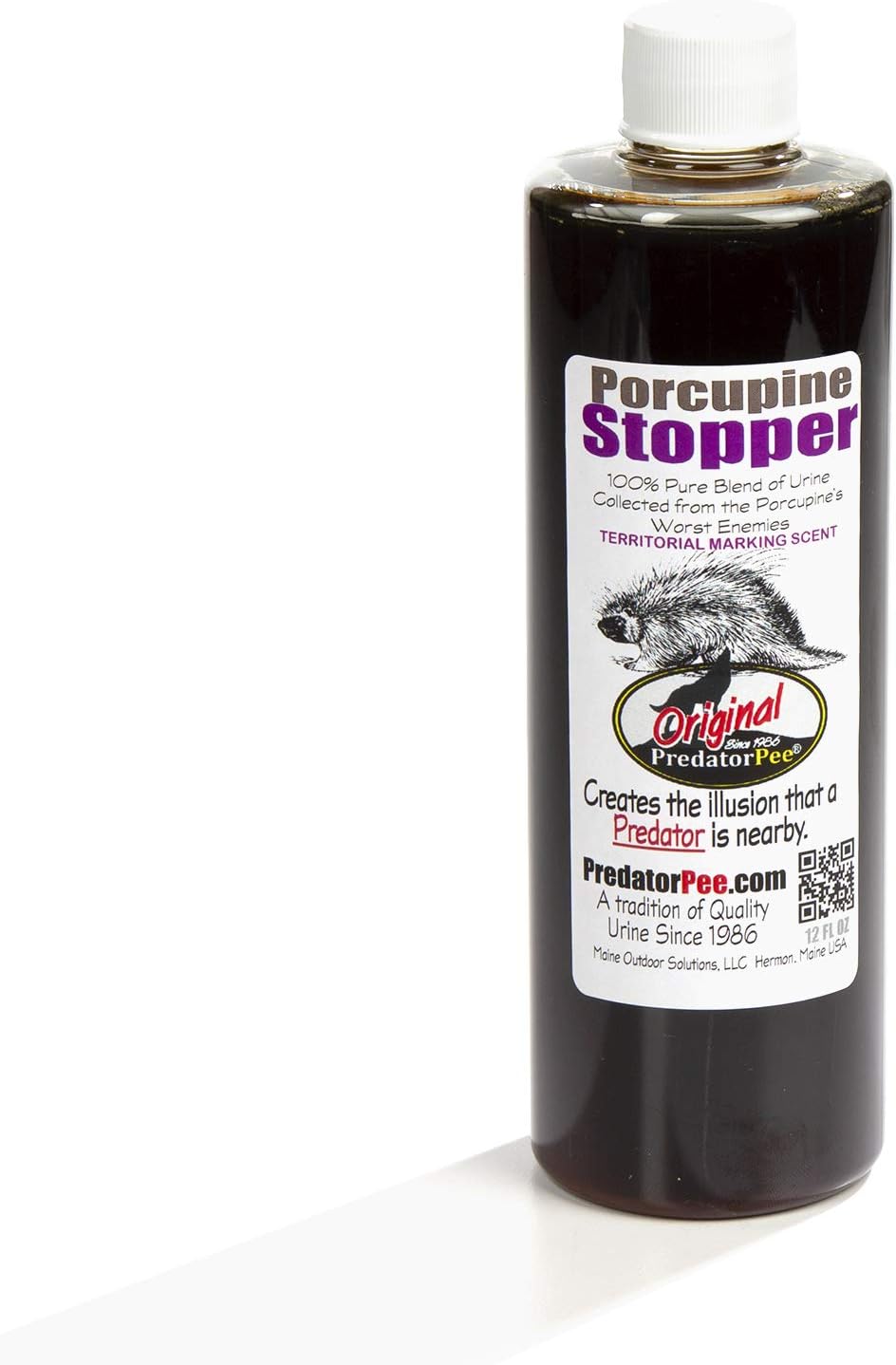- 100% predator urine from
- Fisher Cat, Mt. Lion and Bobcat
- 12 oz. squeeze bottle
- All natural, toxic-free
- Humanely sourced from wild game care providers
Introduction
When it comes to understanding dog coat types, there is a wide variety that requires different grooming routines. From long coats to short coats, each type of dog has unique needs to ensure their coat stays healthy. Double-coated dogs, such as Huskies, and wire-coated breeds, like Terriers, require specialized grooming to maintain their protective layers. Professional grooming is often necessary for dogs with a combination coat or a silky coat, as these breeds usually need more regular attention to keep their fur in top condition. Regular brushing is essential to distribute natural oils throughout their coat, promoting a shiny and healthy look.
Whether your dog has a single coat or a double coat, understanding the best grooming practices is key to keeping their coat close to the body and free from mats. Each dog breed’s coat type requires different levels of care, from the smooth-coated breeds that need minimal grooming to the long and silky-coated dogs that demand more attention. Knowing how to care for different dog coats can ensure your pet’s fur remains vibrant and well-maintained.
Key Takeaways
- Different dog coat types, from hairless to curly coats, require specific grooming techniques to maintain a healthy and shiny coat.
- Hairless dog breeds need extra protection from the sun and consistent skincare routines to avoid skin issues.
- Curly coated dogs need regular brushing and specialized shampoos to keep their fur free from tangles and dirt.
- Double-coated dogs, such as Huskies, require regular brushing to manage seasonal shedding and maintain coat health.
- Wire-coated breeds benefit from hand stripping to maintain their unique fur texture and encourage new coat growth.
- Each dog breed’s coat type requires varying levels of grooming care, from low-maintenance smooth coats to high-maintenance long and silky coats.
Understanding Dog Coat Types: From Hairless Dogs to Curly Coats
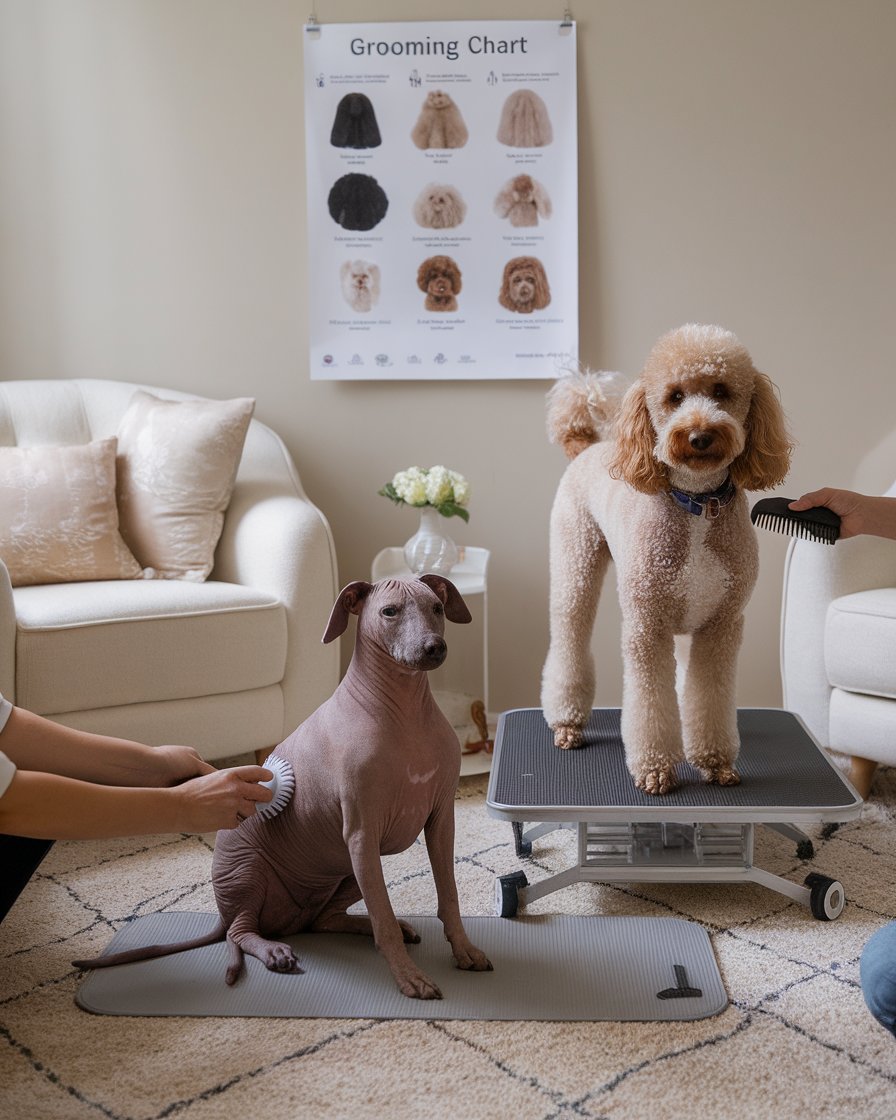
When it comes to understanding dog coat types, variety is the spice of life. From hairless dogs to curly coats, each dog breed has unique grooming requirements. Hairless dog breeds, like the Chinese Crested, need protection from the sun, while curly coated dogs like Poodles require regular brushing to avoid mats. Coats range from smooth coats that need minimal grooming to double coats that shed heavily during seasonal changes. Understanding the differences between fur types is essential for keeping your dog’s coat healthy and well-maintained, ensuring that natural oils are spread throughout their coat.
Grooming Insights for Different Dog Coat Types
1. Special Care for Hairless Dogs
Hairless dog breeds, such as the American Hairless Terrier and Chinese Crested, need extra protection to maintain healthy skin. Without fur, these dogs are more vulnerable to sunburn and other skin conditions, so applying sunscreen and keeping their skin moisturized is crucial. Even though they lack fur, regular grooming is still necessary to clean their skin and prevent dirt buildup. Attention to seasonal changes and temperature regulation is essential for their overall health.
2. Managing Curly Coats to Avoid Tangles
Curly-coated breeds like Poodles and Curly Coated Retrievers require consistent grooming to prevent mats. Their dense, curly fur can easily trap dirt, so regular brushing with a pin brush is important to keep the curls soft and tangle-free. Frequent bathing with a specialized dog shampoo helps maintain their coat, while proper grooming ensures natural oils are distributed evenly throughout their coat, keeping it shiny and healthy.
3. Grooming Double-Coated Breeds for Seasonal Shedding
Double-coated dogs, such as Siberian Huskies and Golden Retrievers, have unique grooming needs due to their seasonal shedding patterns. During periods of heavy shedding, known as “blowing coat,” brushing daily with an undercoat rake is necessary to remove loose fur. Regular grooming helps maintain the insulating properties of their undercoat and keeps their outer coat healthy, protecting them from both cold and heat.
4. Simplified Grooming for Smooth-Coated Dogs
Smooth-coated dogs, like Beagles and Boxers, typically require less grooming than curly or double-coated breeds. A weekly brushing with a soft-bristle brush helps remove loose hairs and dirt while keeping their coat sleek and shiny. Although they don’t shed as much as other coat types, regular grooming is still essential to distribute natural oils and maintain a healthy coat.
5. Hand Stripping for Wire-Coated Breeds
Wire-coated breeds, such as Wire Fox Terriers and Schnauzers, benefit from a specialized grooming technique called hand stripping. This method involves manually removing dead hair from the outer coat to allow new, healthy hair to grow. Hand stripping is essential for maintaining the coarse texture of the wire coat, which regular brushing cannot achieve. Keeping up with this routine helps prevent mats and preserves the durability of their fur.
6. Tailoring Grooming to Each Dog’s Coat Type
Each dog breed’s coat type comes with its own grooming demands. While some, like smooth-coated breeds, require minimal attention, others with long, curly, or double coats need more frequent care. Regular grooming, tailored to the coat’s specific needs, helps promote a healthy, vibrant coat and ensures your dog remains comfortable in different climates and conditions. Understanding the requirements of different coat types is key to effective grooming.
Unique Needs of Hairless Dog Breeds
Hairless dog breeds, such as the American Hairless Terrier, require special care to keep their skin and coat healthy. Without fur to protect them from the elements, these dogs are prone to sunburn and skin irritations. Applying sunscreen and keeping their skin moisturized is essential, especially during seasonal changes. Although they lack a traditional coat, hairless dogs still need regular grooming to ensure their skin remains free of dirt and debris. Proper grooming helps protect their sensitive skin and maintain their overall health.
Managing Curly Coats for a Tangle-Free Fur
Curly coated dogs, like Poodles and Curly Coated Retrievers, require consistent grooming to prevent mats and tangles. Regular brushing with a pin brush helps keep their fur manageable and spreads natural oils throughout the coat. Since curly coats tend to trap dirt more easily, it’s essential to bathe these dogs frequently using a dog shampoo designed for their coat type. Grooming a curly coated dog requires attention to detail, ensuring the curls remain soft and free of knots.
How to Groom a Double-Coated Dog for a Healthy, Shiny Coat
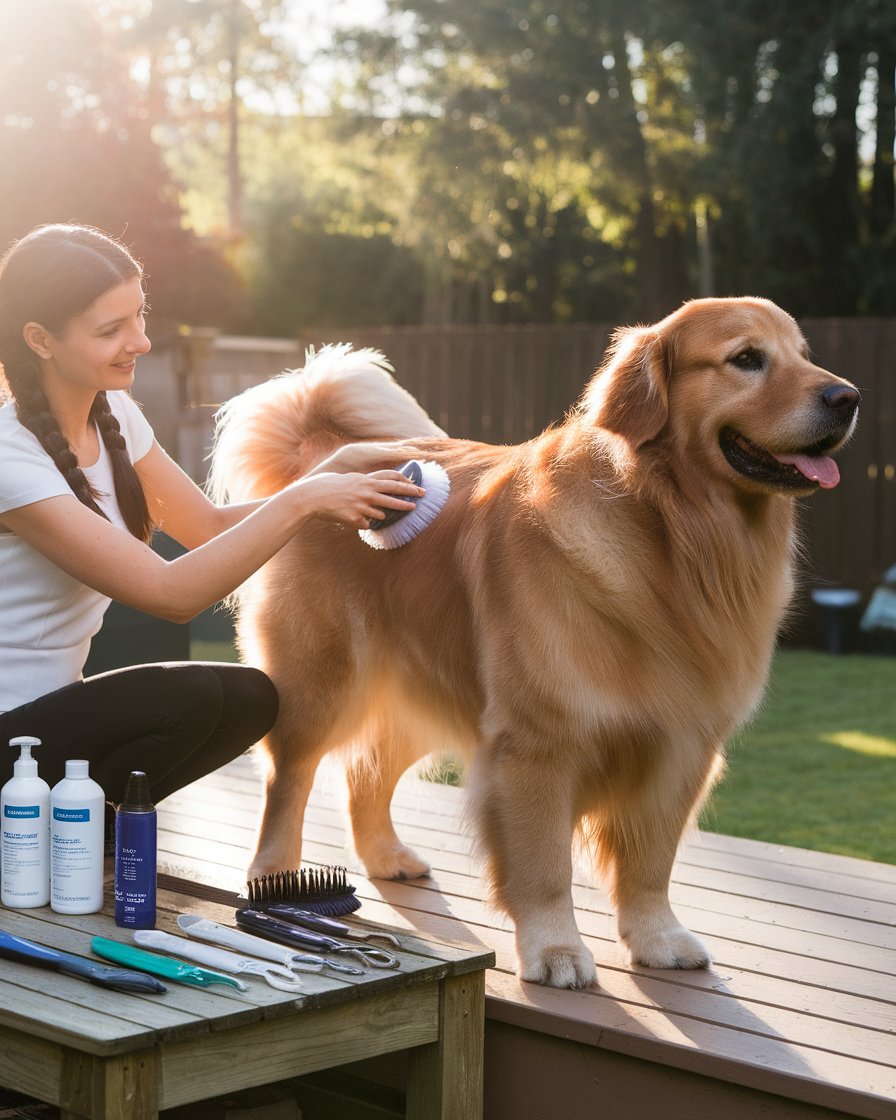
A double-coated dog, such as a Siberian Husky, requires special attention to grooming. The undercoat sheds seasonally, making regular brushing necessary to keep the fur free from tangles and mats. Using a pin brush or slicker brush, dog owners can ensure the double coat stays healthy by distributing natural oils through the fur. Regular grooming helps maintain the outer coat’s protective qualities, which insulates the dog from cold weather and provides sun protection. Grooming a double-coated dog requires patience, but the payoff is a soft, shiny coat that looks and feels great.
Case Study: Grooming a Double-Coated Dog for Optimal Health
In a case study conducted by a veterinary grooming clinic specializing in double-coated breeds, the grooming routine of a Siberian Husky was closely monitored over several seasonal changes. The Husky’s undercoat shed heavily during spring and fall, commonly known as the “blowing coat” period. The owners initially struggled with managing the excess shedding, leading to matting and discomfort for the dog.
To address this, a specialized grooming routine was implemented using an undercoat rake and slicker brush. The Husky was brushed daily during the shedding season to remove loose fur, allowing the skin to breathe and preventing matting. Regular grooming sessions, including baths and the use of a de-shedding tool, helped distribute the natural oils throughout the dog’s fur, promoting a healthy, shiny coat. Over time, the Husky’s coat condition significantly improved, with fewer mats and a reduction in shedding inside the home.
Seasonal Shedding and Double Coats
Double-coated dogs, such as Golden Retrievers, experience heavy shedding during seasonal transitions, commonly known as “blowing coat.” During this time, using an undercoat rake can help remove loose fur from the undercoat and prevent excessive shedding. Regular grooming during these periods helps maintain the coat’s health and prevents matting. Double coats require diligent care to ensure the dog stays comfortable and cool, particularly in warmer months.
Brushing Techniques for Double-Coated Breeds
Effective grooming for double-coated dogs involves using the right brushes for both the undercoat and top coat. A pin brush is great for everyday maintenance, while a slicker brush or de-shedding tool works wonders for tackling thicker fur. Regular brushing helps distribute the dog’s natural oils, which protect the skin and keep the coat healthy. For best results, grooming should be part of a routine to ensure that the coat remains tangle-free and well-conditioned year-round.
Best Grooming Tips for Smooth-Coated and Wire-Coated Dogs
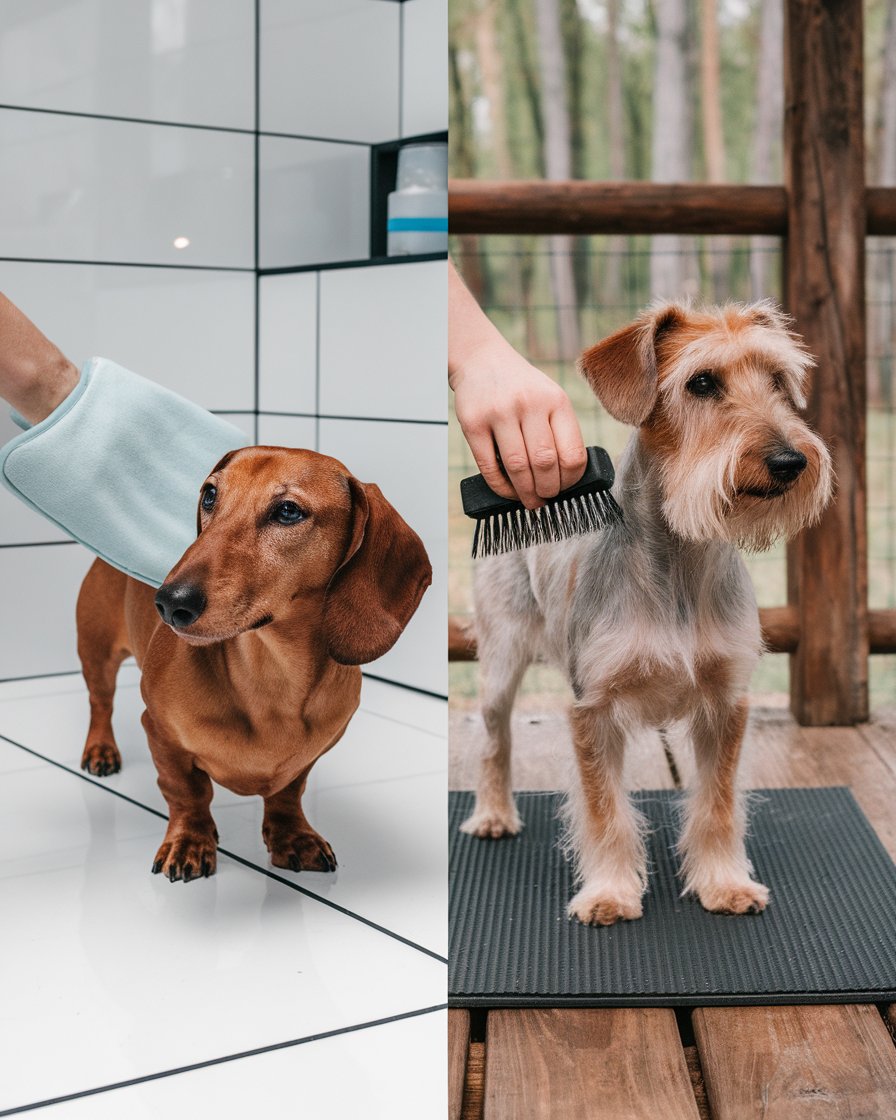
Smooth-coated dogs like Beagles and wire-coated breeds like Terriers have different grooming needs, but both require regular attention to keep their coats in top shape. Smooth coats typically need less grooming, often just a weekly brushing to remove loose fur. Wire-coated dogs, on the other hand, benefit from hand stripping or using a slicker brush to maintain their coarse outer coat. This process helps new coat growth and prevents mats from forming. Regular grooming ensures that your dog’s coat will keep its natural oils and maintain its healthy sheen.
Hand Stripping Techniques for Wire-Coated Breeds
Wire-coated breeds like Schnauzers and Wire Fox Terriers benefit from a grooming technique called hand stripping, which involves plucking the dead hairs by hand to allow new coat growth. This method helps maintain the coarse texture of the coat, which a typical brushing may not achieve. Hand stripping prevents mats and ensures the wire coat retains its durability. While time-consuming, this grooming technique keeps the wire coat in top condition and enhances the dog’s overall appearance.
Easy Grooming Routines for Smooth-Coated Dogs
Smooth-coated dogs, such as Boxers or Bulldogs, require less grooming compared to their wire-coated counterparts. A weekly brushing session with a soft-bristle brush helps remove loose hair and distributes natural oils for a sleek, shiny coat. Regular grooming also allows for early detection of skin irritations or parasites, keeping your smooth-coated dog’s skin healthy and free from issues. Despite their low-maintenance grooming needs, smooth-coated dogs still benefit from occasional baths and check-ups to ensure their coat stays fresh and clean.
“Pets, like their owners, tend to expand a little over the Christmas period.” – Frances Wright
Exploring the Fur Types: What You Need to Know About Dog Coat Types
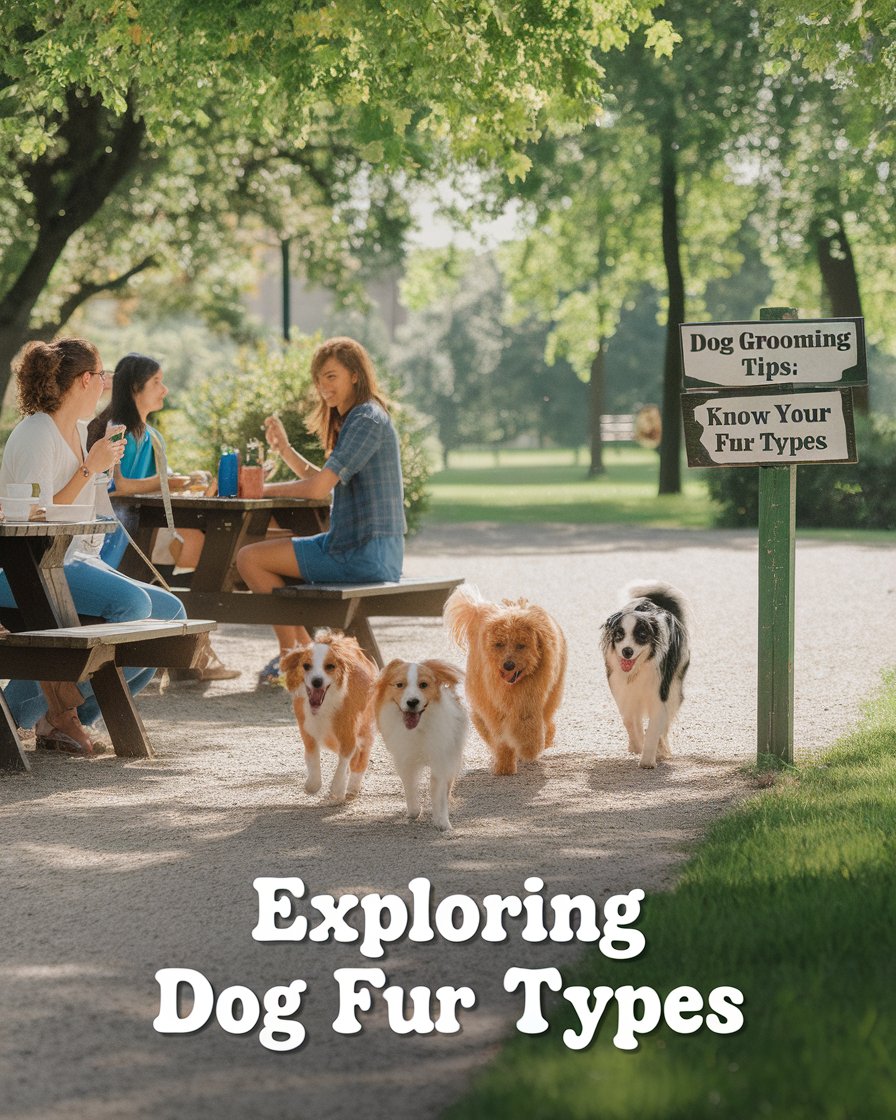
Dogs come in a variety of fur types, and each coat type requires a different grooming approach. Long-coated dogs like Afghan Hounds need regular grooming to prevent mats, while short-coated breeds like Dachshunds require less frequent care. Single-coated breeds don’t shed as much as double-coated ones, but they still need brushing to remove loose fur and distribute natural oils. Understanding the grooming requirements for different dog coat types is crucial for keeping your pet’s coat healthy and vibrant. Whether your dog has silky fur or a rough coat, proper grooming will keep them comfortable and looking their best.
Grooming Long-Coated Breeds for Healthy Fur
Long-coated breeds, such as Afghan Hounds and Shih Tzus, need daily grooming to prevent their fur from tangling or matting. Using a detangling spray along with a pin brush can make the grooming process easier and more effective. Regular brushing also helps spread the natural oils through their coat, ensuring that it remains silky and shiny. Long-coated breeds tend to require more frequent bathing and drying routines to keep their fur in top shape.
Caring for Short-Coated Breeds
Short-coated breeds, like Dalmatians and Greyhounds, don’t require as much grooming as long-coated dogs, but they still benefit from weekly brushing. A soft-bristle brush helps remove dead hair and keeps the coat looking clean and healthy. Regular grooming sessions allow for checking the skin for any abnormalities, such as dry patches or parasites. While short-coated dogs may not shed as heavily as double-coated breeds, maintaining a grooming routine is still crucial for their well-being.
Conclusion
In conclusion, understanding the various dog coat types is essential for ensuring proper grooming and care. Whether your dog has a single or double coat, each coat type requires regular grooming to maintain a healthy coat. Double-coated dogs, such as Huskies, need more frequent brushing to manage shedding, while smooth-coated breeds require less but consistent care. Regular grooming ensures that the natural oils throughout your dog’s coat are evenly distributed, which helps keep their coat silky and smooth.
Each dog breed has unique grooming needs, and knowing the type of coat your dog has, whether it’s a wire-coated or long-haired breed, is vital. Dogs with this coat type may need professional grooming or more frequent at-home care. Regular brushing is key to maintaining your dog’s healthy coat and preventing mats. By understanding the types of dog coats and how to care for them, you can ensure your dog remains comfortable, clean, and well-groomed.

James Dunnington leads the James Dunnington Collection, featuring five unique blogs: a practical Pet Care Guide, an enlightening Ancient History Blog, a resourceful Home Improvement Guide, a cutting-edge Tech Innovation Guide, and a strategic Online Money Making platform. Each site delivers valuable insights designed to empower and inform. For updates and more tips, visit our Contact Us page to sign up for our newsletter, ensuring you never miss out on the latest content from any of these dynamic fields.
